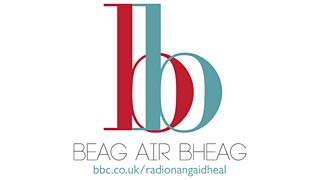Oisean a’ Ghrà mair Sreath 10: 12
Criomag: Dòmhnall Meek (‘Bràthair Mo Sheanar’)

1. Sùil air ais: ‒MAID ‘We would’ (Faic Prògram 8)
Dòmhnall:
“ ’S e rector a theireamaid ri ceannard na sgoile anns an Òban.”
“We used to call the headmaster in Oban ‘rector’.” (‘It’s rector (that) we would call... .’)
‘They used to call him rector.’ ’S e rector a theireadh iad ris.
theireadh = chanadh
theireamaid = chanamaid
2. Sùil air ais: GA MO, GA DO, GA,... : ‘X-ing me, you, him/her,, etc.’ (Faic Prògram 8)
Dòmhnall:
“Is bha sin cuideachd ga chur car air leth.” “That also was setting him apart.”
‘at his putting no setting apart’, ga chur air leth. setting him apart.
Bha e ga mo chur dheth. ‘It was putting me off.’ It was at my putting’
Bha iad ga do chur sìos. ‘They were putting you down.’
3. Sùil air ais: An tuiseal ginideach | the genitive case (Faic Prògram 7)
Dòmhnall:
“ ’S e rector a theireamaid ri ceannard na sgoile anns an Òban.”
“We used to call the head of the school in Oban ‘rector’.”
“Dh’fhalbh mi fhìn is mo mhàthair suas gu àrd-sgoil an Òbain.”
“Me and my mother went up to the high school of the little bay (Oban High School).”
“Bha i àrd os cionn an rathaid mhòir.”
“She (= the school) was high above the main road.”
an sgoil - ‘the school’ na sgoile - ‘of the school’ (feminine)
ceannard na sgoile - ‘the head of the school’
an t-Òban - ‘the wee bay’ (Oban) an Òbain - ‘of the wee bay’ (masculine)
àrdsgoil an Òbain - ‘the high school of the wee bay’ (Oban High School)
OS CIONN ‘above’ (‘over the head of’) + tuiseal ginideach (genitive case)
an rathad mòr - ‘the main road’ an rathaid mhòir - ‘of the main road’
‘above the main road’: os cionn an rathaid mhòir
‘above the school’: os cionn na sgoile
‘above the little bay, above Oban’: os cionn an Òbain
‘above the houses’: os cionn nan taighean
‘above me / above you / above him / above her’:
os mo chionn, os do chionn, os a chionn , os a cionn
‘above us / above you / above them’:
os ar cionn, os ur cionn, os an cionn
(‘over my head’, ‘over your head’, etc.)
4. Sùil air ais: CHO (brèagha) AGUS A bha i | ‘HOW (beautiful) it was’ (Faic Prògram 11)
Dòmhnall:
“Bha binneanan brèagha oirre, agus leis cho brèagha ’s a bha i, bha fhios agad gun robh thu a’ dol a dh’àiteigin àrd.”
“It had beautiful turrets, and with (because of) how beautiful it was, you knew you were going to somewhere high, prestigious’.
cho brèagha agus a bha i - ‘how beautiful (and that) it was’
5. PUING ÙR: GABH ‘can be’, GHABHADH ‘could be’
Dòmhnall:
“Cha ghabhadh e creidsinn gun robh thu ann an sgoil.”
“You couldn’t believe (that) you were in a school.” (‘It wouldn’t take believing…’)
Cha ghabhadh e dèanamh.
‘It couldn’t be done.’ (‘It wouldn’t take doing.’)
Gabhaidh e dèanamh.
‘It can be done.’ (‘It’ll take doing.’)
An gabh e leughadh?
‘Can it be read? Is it legible?’ (‘Does it take reading?’)
An gabh e tuigsinn?
‘Can it be understood, is it comprehensible?’ (‘Does it take understanding?’)
Tha mi ‘n dòchas gun gabh na notaichean tuigsinn.
‘I hope the notes are understandable.’
6. PUING BHEAG EILE: ’S e ... a bha ANN / a bha INNTE ‘HE/SHE/IT was a ...’
Dòmhnall:
“’S e reachdaire a bh’ ann.”
“He was a rector.”
“B’ e àrd-sgoil a bh’ innte anns a h-uile dòigh.”
“It (‘she’) was a high school in every way.”
ann - ‘in him, in it (masculine)’
innte - ‘in her, in it (feminine)’
’S e togalach brèagha a bh’ ann.
‘It was a beautiful building.’ (‘in him’)
’S e àrdsgoil bhrèagha a bh’ innte.
‘It was a beautiful school.’ (‘in her’)

